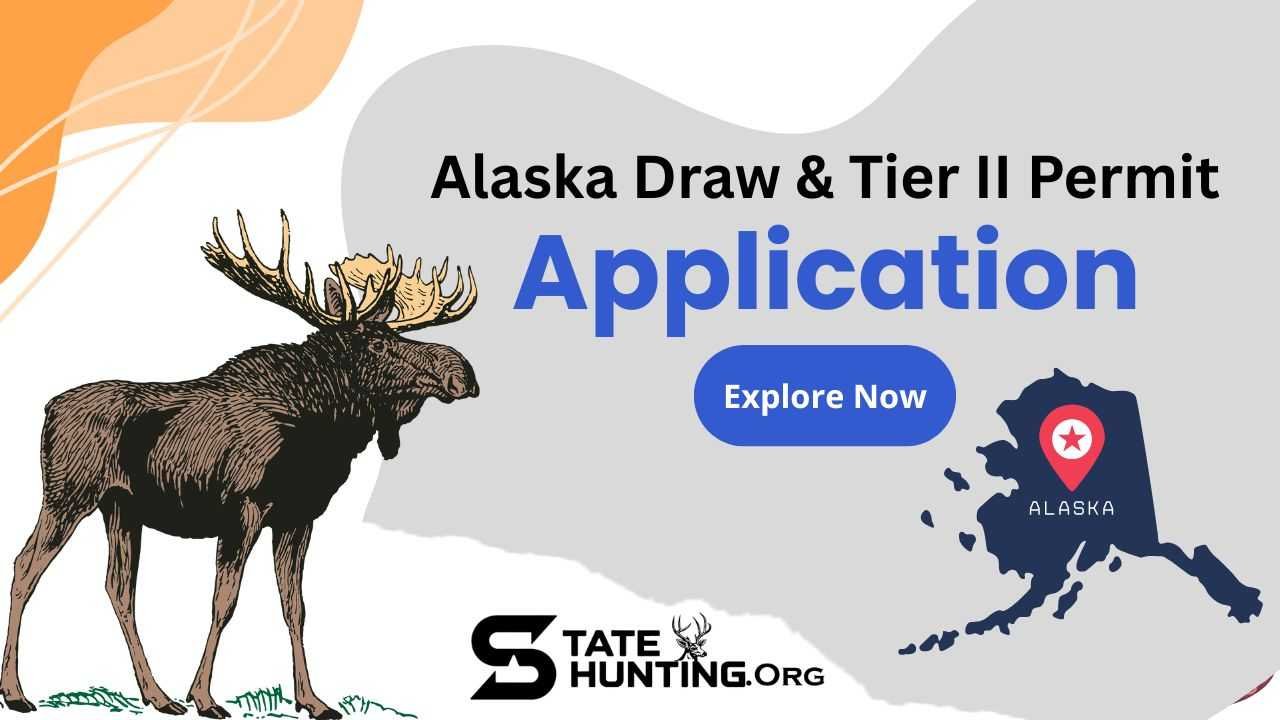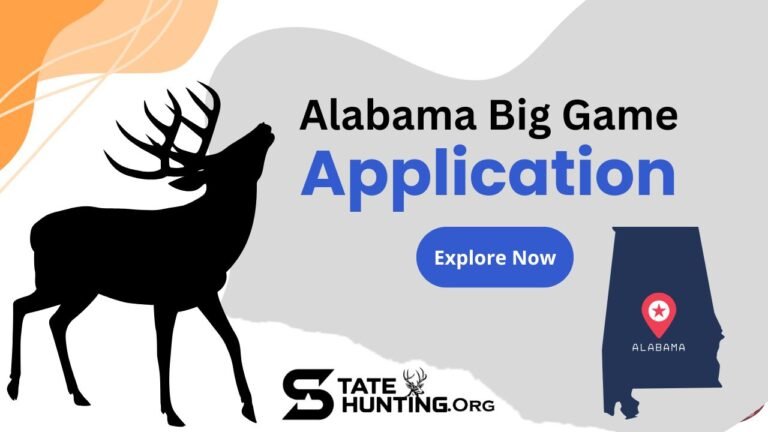📅 2025-2026 Alaska Draw Application Deadlines and Tier II Permit Hunts
Dreaming of hunting Alaska’s vast wilderness? The Last Frontier offers some of North America’s most spectacular hunting opportunities, from massive moose to majestic Dall sheep. But navigating Alaska’s draw system requires careful planning and strict attention to deadlines. This guide breaks down everything you need to know about applying for Alaska’s 2025-2026 limited entry hunts, including key dates, species information, and practical tips to maximize your chances of drawing a tag. Whether you’re a resident or nonresident, understanding these processes is essential for securing your chance at an unforgettable hunting adventure.
📅 Summary of 2025-2026 Alaska Drawing Hunt Deadlines
| Species Available | Application Open Date | Application Deadline | Draw Results Date | Notes |
|---|---|---|---|---|
| All Drawing Species (Combined) | November 1, 2024 | December 16, 2024, 5pm AKST | February 21, 2025, ~8am AKST | Single application period for all species |
| Moose | November 1, 2024 | December 16, 2024, 5pm AKST | February 21, 2025 | Nonresidents need orientation course |
| Caribou | November 1, 2024 | December 16, 2024, 5pm AKST | February 21, 2025 | Registration permits in some units |
| Dall Sheep | November 1, 2024 | December 16, 2024, 5pm AKST | February 21, 2025 | Guide required for nonresidents |
| Mountain Goat | November 1, 2024 | December 16, 2024, 5pm AKST | February 21, 2025 | ID quiz required; guide for nonresidents |
| Brown/Grizzly Bear | November 1, 2024 | December 16, 2024, 5pm AKST | February 21, 2025 | Guide required for nonresidents |
| Bison | November 1, 2024 | December 16, 2024, 5pm AKST | February 21, 2025 | Limited units; $10 application fee |
| Muskox | November 1, 2024 | December 16, 2024, 5pm AKST | February 21, 2025 | Limited availability; $10 application fee |
| Elk | November 1, 2024 | December 16, 2024, 5pm AKST | February 21, 2025 | Limited to specific islands |
1. 🔗 Application Process Overview
Applying for Alaska’s drawing hunts is exclusively online through the Alaska Department of Fish and Game (ADF&G) website. Paper applications are no longer accepted . Here’s how it works:
- Create an Account: You’ll need a Conservation ID number, which can be obtained through the ADF&G system.
- Purchase Licenses: Before applying, you must have a valid hunting license. For the 2025-2026 draws, you can use a 2024, 2025, or 2026 license .
- Select Hunts: You can apply for up to six hunt choices per species, and you can select the same hunt multiple times to increase your odds .
- Submit Application: Pay the non-refundable application fees ($5 per choice, $10 for bison/muskox) .
- Confirmation: Keep a record of your submission confirmation.
Eligibility Requirements:
- Residents and nonresidents may apply for most draws .
- Nonresidents must have a licensed guide for sheep, goat, and brown/grizzly bear hunts OR be accompanied by a qualified resident relative (second degree of kindred) .
- Hunters must be at least 10 years old by the hunt start date .
- Those born after January 1, 1986, must complete a hunter education course .
2. 🦌🐻🦬 Big Game Species Breakdown
Alaska offers incredible diversity in its big game opportunities. Here’s what you can expect:
Moose: Alaska’s premier big game animal offers both general season and draw opportunities. The 2025 season brings a new requirement: ALL nonresident moose hunters must complete a mandatory orientation course before hunting . Popular units include 20A-F (Fairbanks area), Unit 13 (Nelchina), and Unit 19 (McGrath) .
Caribou: Multiple herds provide diverse opportunities across the state. The Fortymile Herd (Units 20B, 20E, 25C), Western Arctic Herd (Units 22, 23, 26), and Central Arctic Herd (Unit 26) offer some of the best access and success rates .
Dall Sheep: Alaska’s majestic mountain sheep require careful planning. Prime units include Unit 13 (Chugach Range), Unit 20 (White Mountains and Alaska Range), and Units 23-26 (Brooks Range wilderness) . Full-curl horn restrictions apply in most units .
Brown/Grizzly Bear: These impressive bears have varying seasons across units. For 2025-2026, notable changes include extended seasons in Units 9D, 9E, and RB368, and increased bag limits to two bears per regulatory year in Unit 13 .
Mountain Goat: Challenging hunts in steep terrain require excellent physical conditioning. Top destinations include Units 1-5 (Southeast coastal ranges), Units 6-7 (Chugach Mountains), and Unit 8 (Kodiak Island) . All goat hunters must now complete a mountain goat identification quiz before hunting .
Bison and Muskox: These limited-opportunity species require drawing permits with higher application fees ($10). Bison hunts are available in Units 11, 13, 19, and 20, while muskox is primarily found on Nunivak Island (Unit 18) and the North Slope .
3. 🎯 Draw System & Points
Alaska operates a straightforward lottery system without preference or bonus points . This means every applicant has an equal chance each year, regardless of how many times they’ve applied unsuccessfully in the past.
However, you can significantly increase your odds for specific hunts by applying for the same hunt multiple times. Since you can select up to six choices per species, applying six times for the same hunt code gives you six times better odds than applying just once .
Important Changes for 2025-2026:
- Nonresident Moose Orientation: All nonresident moose hunters must complete a mandatory orientation course .
- Mountain Goat ID Quiz: All goat hunters must complete an identification quiz before hunting .
- Sheep Hunter Education: Beginning July 2026, all sheep hunters must complete a state-approved orientation course for Aug. 10-Sept. 10 general harvest ticket hunts .
- Boundary Adjustments: Units 25C and 25D boundaries have changed to the Steese Highway between Milepost 147 and Circle .
4. 🎟️ Permit & Tag Information
Fees:
- Nonresident Annual Hunting License: $160
- Application Fee (per choice): $5 ($10 for bison/muskox)
- Locking-Tag Fees (if successful):
- Moose: $800
- Caribou: $650
- Dall Sheep: $850
- Brown/Grizzly Bear: $1,000
- Mountain Goat: $600
- Bison: $900
- Muskox: $2,200
Resident vs. Nonresident Quotas:
While most drawing hunts are available to both residents and nonresidents, some hunts have specific allocations. Nonresidents should note that for species requiring guides (sheep, goat, brown bear), they must have a guide-client agreement in place BEFORE applying .
Over-the-Counter Opportunities:
Many species in Alaska are available through registration permits or general harvest tickets rather than drawing permits. These include:
- Black bear (no closed season in most units)
- Caribou (registration permits in many units)
- Moose (harvest tickets in many areas)
Registration permits are typically available on a first-come, first-served basis and can be obtained online, at ADF&G offices, or at designated locations near hunt areas .
5. 💡 Tips for Applicants
- Apply Strategically: Since Alaska doesn’t use preference points, apply for your dream hunts every year. You can increase your odds by applying multiple times for the same hunt code .
- Research Thoroughly: Use the Draw Hunt Supplement published annually by ADF&G to understand specific hunt codes, areas, and previous success rates .
- Plan for Logistics: Alaska hunts require extensive planning, especially for remote areas. Transport costs have increased significantly, with drop-off hunts ranging $8,000-$15,000 per hunter .
- Check Results Promptly: Draw results will be available online by February 21, 2025 . If successful, you’ll need to purchase your locking-tag before hunting.
- Understand Tagging Down: Alaska allows “tagging down” – using a higher-value tag for a species of equal or lesser value. For example, if you have a brown bear tag but harvest a caribou instead, you can use the bear tag for the caribou .
6. 🦃🐇🦆 Additional Hunts & Opportunities
Youth Opportunities: Youth-only hunts are available but restricted to Alaska resident youth or youth accompanied by an Alaska resident relative .
Special Hunts: Alaska offers opportunities for disabled hunters, including proxy hunting for bison that has been added for the elderly and disabled .
Migratory Birds: Waterfowl and other migratory bird seasons are set by federal regulations and published separately in mid-August. These require federal duck stamps and state waterfowl stamps in addition to hunting licenses .
Furbearers: Species like lynx, beaver, wolf, and wolverine have specific seasons and requirements. For example, wolf seasons typically run August 1 – April 30 in most units with bag limits of 5-20 animals .
While Alaska doesn’t have wild turkey populations, it offers excellent opportunities for other upland birds like ptarmigan and grouse . If you’re interested in turkey hunting, you might want to check out opportunities in other states like Alabama .
✅ Conclusion
Staying ahead of Alaska’s hunting application deadlines is crucial for securing your chance at some of North America’s most spectacular hunting adventures. Remember that the single application period for all drawing hunts runs from November 1, 2024, to December 16, 2024, at 5pm AKST .
Bookmark the official Alaska Department of Fish and Game page for the most current information and regulations. The Draw Hunt Supplement, typically available in fall, contains essential details on specific hunt opportunities .
Whether you’re dreaming of a massive moose, majestic Dall sheep, or any of Alaska’s other incredible big game species, remember to apply early, double-check all regulations, and prepare for the adventure of a lifetime. Good luck, and may your 2025-2026 hunting season be filled with unforgettable experiences in the Last Frontier! 🏹


